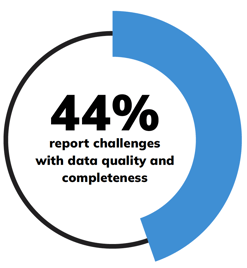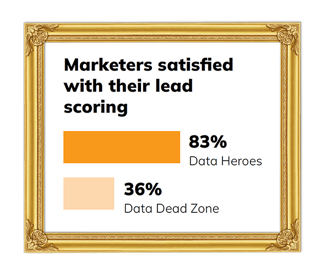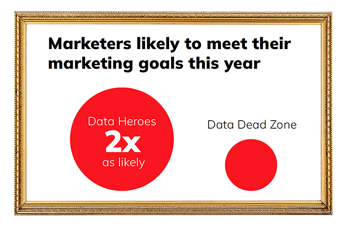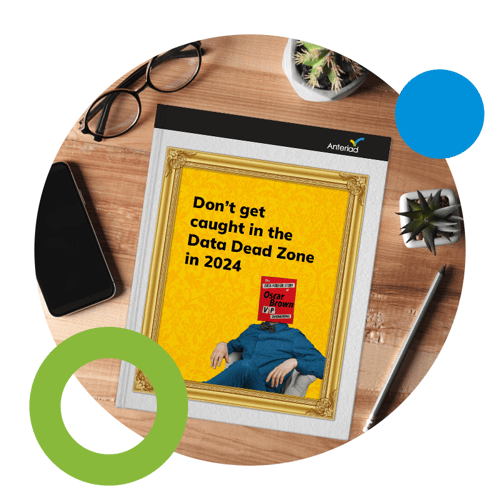Introduction
B2B marketers have a tough situation on their hands. On one side, their goals are more challenging than ever. On the other side, their budgets are being squeezed. Having to do more with less is tough, and B2B organizations are making it even tougher, requiring marketers to “prove it or lose it.” That is, show that they’ve driven revenue, or lose budget.
At the same time, B2B buyers are changing significantly. They’re much more likely to use online channels to search for information, research solutions and even transact online. Winterberry Group calls this the “consumerization” of B2B marketing in their recent report “Outlook for B2B Marketing, A Market In Transformation.” B2B buyers are starting to look more like B2C buyers, and it’s dramatically shifted the strategies that B2B marketers need in order to succeed. Regular consumers search, shop, and transact online in large numbers, and B2C marketers have spent years collecting customer data and creating data-driven technology stacks to market to them based on their online behavior.
Our research shows that there are some B2B marketers who are thriving through this time of change. Their secret? Better data and better use of data. They reported in the 2023 Data Impact Report that they have the right data and can prove it in their pipeline.
We’ve defined these B2B marketers as Data Heroes. These marketers saw significant growth in the past year (43% saw significant revenue growth vs 13% of other marketers) and are getting bigger budgets (78% of them!) because of their data-driven approach.
However, there are plenty of marketers who aren’t experiencing the same data-driven nirvana. Of all the marketers surveyed, 44% of them reported challenges with data quality and completeness. These unfortunate marketers are in the Data Dead Zone. While 100% of the Data Heroes report they use the right data and can prove it in their pipeline, only 26% of those in the Data Dead Zone could say the same.
Left behind in the Data Dead Zone?
Here are the five signs that you’re in the Data Dead Zone. If more than two of these apply, read on!

We defined those being in the Data Dead Zone as the B2B marketers who reported a top challenge associated with 2nd and 3rd party data being its data quality and completeness because good, comprehensive data is the key to a successful marketing strategy. While 100% of marketers in the Data Dead Zone are challenged by data quality, only 44% of Data Heroes are.
B2B marketers in the Data Dead Zone lack confidence in their data, and that can affect their entire marketing strategy. Chances are data is old, sitting in different databases, or not coming from top-quality sources. When this happens, your data isn’t powering your audience insights, targeting, and measurement as it should be.
Intent data is a newer form of buyer insight that helps you prioritize and personalize marketing outreach. If someone shows stronger intent to buy, they should be getting more attention and a higher lead score. Knowing what a prospect intends to buy can help you tailor content and offers to their needs. Not surprisingly, marketers in the Data Dead Zone aren’t as experienced with intent data, aren’t able to drive as much value with it, and so aren’t planning to use more of it; only 4 out of 10 of these marketers currently use intent data. Marketers in the Data Dead Zone are also more likely to be using intent data from their own sources such as their website, vs. third-party intent data.
This matters because they likely aren’t seeing the full scope of intent data that they could unlock through a third-party intent provider. While they can see a small portion of a prospect's behavior that points to intent, like downloading an eBook from their site, they aren’t able to get the full story of how they are engaging on other websites and platforms. This means they’re also missing out on prospects who aren’t engaging on their site but are showing high intent for their products or services.
On the other hand, Data Heroes are getting the most out of intent data. They are not only using intent, they are using it for more than just targeting and content; they’re implementing more sophisticated use cases.

Unhappy with lead scoring methodology?
Download the full report and bookmark these tips.
Lead scoring is the thread that runs through most marketing programs. It’s what ties marketing to sales, what leaders use to gauge the value of marketing activity, and how marketers prioritize one marketing strategy over another. When lead scoring isn’t working, it’s hard for marketers to get anything right.
The vast majority of Data Heroes, 83%, are satisfied  with their lead scoring, compared to only 36% of marketers in the Data Dead Zone. What’s more, Data Heroes are more likely to be using newer scoring techniques – 61% of Data Heroes use buying group scoring compared to only 42% in the Data Dead Zone. Marketers in the Data Dead Zone are most likely to be focused on engagement.
with their lead scoring, compared to only 36% of marketers in the Data Dead Zone. What’s more, Data Heroes are more likely to be using newer scoring techniques – 61% of Data Heroes use buying group scoring compared to only 42% in the Data Dead Zone. Marketers in the Data Dead Zone are most likely to be focused on engagement.
While scoring for content consumption or engagement may not tell the whole story, it is OK to have it as part of your scoring methodology. What sets Data Heroes apart is they are layering more metrics to tell a more complete story for their leads.

Little exposure to B2C marketing tactics?
Download the full report and bookmark these tips.
Our study shows that marketers in the Dead Zone are much more likely to work at companies that only sell to other businesses. While 63% of Data Heroes sell to both consumers and businesses, only half of marketers in the Data Dead Zone sell to consumers as well. Having exposure to B2C marketing helps B2B marketers adapt to the “consumerization” of B2B buyers.
Consumerization refers to the fact that more B2B buyers are starting to approach the purchase process like they would for personal shopping - using digital channels, preferring more self-directed product research and purchase, seeking insights from social proof and peer validation, and expecting personalized marketing.
Winterberry Group notes that B2B buyers are used to a more intuitive experience and want the same ease and convenience in a B2B purchase experience that they get elsewhere. They are seeing more B2B marketers focus on improved UX design, customer care and omnichannel marketing to meet customers where they are.
If your company doesn’t do any B2C marketing, you likely don’t have the benefit of tapping into pre-existing digital marketing processes and technologies that address the consumerization of your buyers.
Marketers in the Data Dead Zone have a tougher time meeting goals; they are half as likely than the Data Heroes t o have reported that they are very likely to meet their marketing goals this year. The difference is in the details. If any of the issues above are plaguing your team, then meeting goals is going to be tough.
o have reported that they are very likely to meet their marketing goals this year. The difference is in the details. If any of the issues above are plaguing your team, then meeting goals is going to be tough.
Download the steps to get out and stay out of the Data Dead Zone
If you’re feeling stuck in the Data Dead Zone, it’s not too late to get out. By addressing a few key issues you can rise to the ranks of the Data Heroes. Data Heroes see more improved metrics, can prove the value of their efforts, and are more confident about hitting goals than their peers.
To get started, follow this checklist with the actions to take and resources to guide you through fixing each of the challenges you may be experiencing in the Data Dead Zone.




